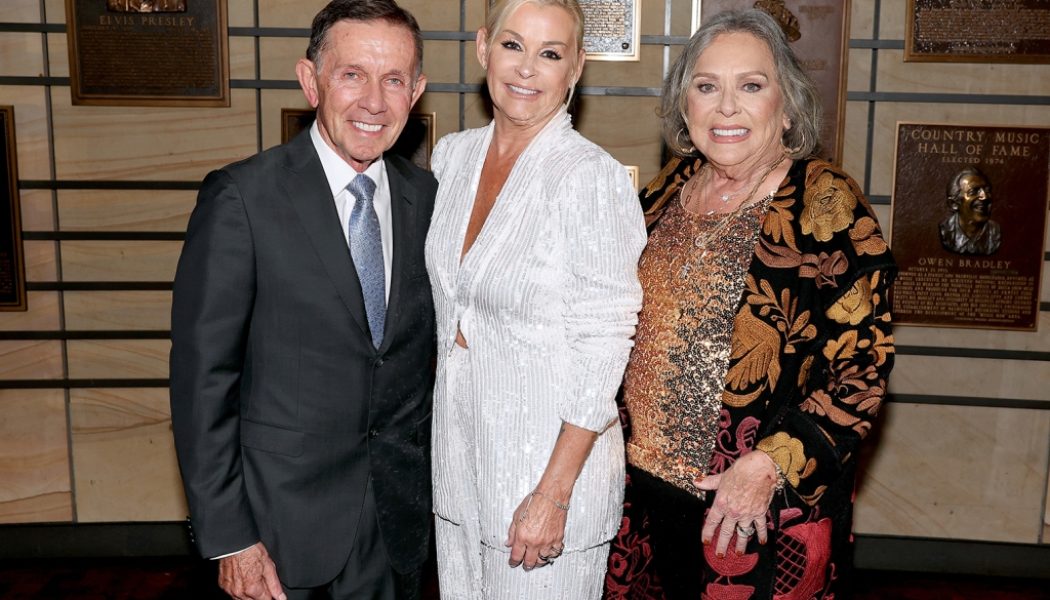
The country music industry may be centered in Nashville, but much of the talent and sound behind Music City’s best-known export originates elsewhere.
The Country Music Hall of Fame medallion ceremony on Oct. 16 provided a strong reminder that the genre synthesizes people, style and abilities from across America. Late honoree Keith Whitley found his way to Nashville from eastern Kentucky through a bluegrass portal. Record executive Joe Galante brought marketing savvy to town from New York after working rock records by David Bowie and Lou Reed.
And Jerry Lee Lewis — forced by an illness to stay home — developed his flashy piano playing and performance skills after hanging out at R&B/blues club Haney’s Big House in Ferriday, La., before launching his recording career in Memphis ahead of his shift to country in 1968.
The first performance during the induction — Alabama’s “My Home’s in Alabama,” a song that was key in the band signing with Galante at RCA in 1980 — clung to that concept, celebrating the group’s hometown roots despite exploring a range of American cities.
The rest of the guest list similarly represented multiple facets of popular music and geographical backgrounds. Oklahoman Garth Brooks found all the dramatic high points of Whitley’s “Don’t Close Your Eyes” in a guitar/vocal format, ironically closing his own eyes during the chorus while seemingly channeling the song’s lead character. Texan Lee Ann Womack created spine-tingling sensitivity in her version of Lewis’ “Middle Age Crazy,” infusing the late-’70s ballad with fierce sympathy and just a touch of scorn. East Tennessee-born Kenny Chesney fought through the emotionally challenging country love song “The Good Stuff,” a title that found favor in part because Galante pushed for its release to radio. And former San Francisco resident Chris Isaak delivered a faithful rendition of the Killer’s “Great Balls of Fire,” replete with heavily reverbed vocals and Jen Gunderman’s interpretation of Lewis’ piano-banging and shiny glissandos.
Galante recalled in his acceptance speech that late BMI executive Frances Preston, a 1992 Hall inductee, had told him that country music revolves around the song and the artist. That combination of impactful songs and distinct artists describes the works that defined the medallion ceremony’s honorees.
Lewis rode his “pumping piano” — as it was listed on the label of his early Sun recordings — to a singular place in rock and country history, with “Great Balls of Fire” and “Whole Lotta Shakin’ Going On” succeeding in both genres in the late 1950s. He refocused on country in 1968, leading to a 13-year run of hits that included a remake of “Chantilly Lace,” honky-tonk hit “What’s Made Milwaukee Famous (Has Made a Loser Out of Me)” and an improbable take on “Over the Rainbow,” bolstered with a self-reference to “ol’ Jerry Lee.”
“Jerry Lee doesn’t walk onstage and politely thank an audience for being there,” Hank Williams Jr. said while inducting the Killer. “Jerry Lee doesn’t ask for your attention. He demands it. He doesn’t take the stage. He commands it … Jerry Lee doesn’t play songs. He owns songs.”
Whitley applied a rich vocal tone to tunes he inhabited emotionally. “Don’t Close Your Eyes,” “I’m No Stranger to the Rain” and “When You Say Nothing at All” — performed by Mickey Guyton during the ceremony while Hall of Fame member Don Schlitz, who co-wrote it, watched from the audience — provided his first three No. 1 hits in just a few months in the late 1980s, earning significant airplay at the time he died from alcohol poisoning in 1989. Where Lewis is famously confident, Whitley hid lingering self-doubts, a trait that was perhaps key to his ability to embody sadness and vulnerability in his recordings.
“Keith was three weeks away from being made a member of the Grand Ole Opry when he passed away,” recalled Lorrie Morgan, who was his wife at the time. “He didn’t know it. And he would have never suspected this [induction] in his life.”
Whitley’s breakthrough made him an addition to the new traditionalist movement of that era, and he became a significant influence on many acts who followed him, including Tim McGraw, Chris Young and Brooks, who officially inducted him into the Hall.
“This night,” Brooks announced, “is long overdue.”
Galante, meanwhile, was hailed as an executive who, by asking the right questions, helped the country industry better understand its product, its audience and the connection between them. He developed data, as Hall of Fame CEO Kyle Young noted, that informed difficult decisions and inspired marketing plans for a product that had frequently been worked on gut instinct. Not that Galante operated strictly from a mathematical playbook.
“Joe also looked beyond the numbers, to the things you can’t quantify, like originality and heart,” said Young. “He overruled the data when it felt right.”
Galante’s successes were numerous. He directed key campaigns for Waylon Jennings, Dolly Parton, Ronnie Milsap, Carrie Underwood, Martina McBride and Miranda Lambert, who performed a guitar/vocal version of “White Liar” in his honor. Kix Brooks, while inducting Galante, noted that Brooks & Dunn was contemplating a split when a merger put the executive in charge of their label. The chance to work with “Joe frickin’ Galante” was enough incentive for the duo to give it one more try, which turned into a second 10-year run.
Galante’s own sensitivities were on display during his acceptance speech, where he told how his father, a 30-year postal service employee, had never understood the job that consumed his son. He discovered only after his dad’s death that the elder Galante had routinely purchased Billboard off newsstands in New York and saved photos and stories about his boy.
“You get the point,” Galante said, just before the emotion took over the story.
Ultimately, it’s those human tales — the ones delivered by singular artists — that built both Music City and the Rotunda that houses the bronze plaques of the Country Music Hall of Fame. Johnny Cash, Jimmie Rodgers and Willie Nelson will have to make room for three more occupants who made their entrance somewhere else but left their mark in Nashville.
[flexi-common-toolbar] [flexi-form class=”flexi_form_style” title=”Submit to Flexi” name=”my_form” ajax=”true”][flexi-form-tag type=”post_title” class=”fl-input” title=”Title” value=”” required=”true”][flexi-form-tag type=”category” title=”Select category”][flexi-form-tag type=”tag” title=”Insert tag”][flexi-form-tag type=”article” class=”fl-textarea” title=”Description” ][flexi-form-tag type=”file” title=”Select file” required=”true”][flexi-form-tag type=”submit” name=”submit” value=”Submit Now”] [/flexi-form]










Tagged: Awards, Country, entertainment blog, music, music blog, Music News